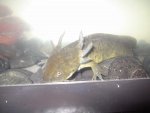Reptileguy2727
New member
- Joined
- May 8, 2007
- Messages
- 96
- Reaction score
- 1
- Points
- 0
- Location
- Northern Virginia
- Country
- United States
I found these in a shop. They have a bunch running 10.99. The body matches an axolotl perfectly but the pattern looks like a tiger salamander's. They are all about 8". I read online that tigers can stay larval if terrestrial conditions are unfavorable or they can simply not metamorphosize until fully grown (among other possibilities), so it does seem possible that these are tiger salamanders. The thing that throws me off is that the bodies are identical to that of axolotls. I saw the pic on axolotls.org of a larval tiger salamander, showing how similar they are in appearance. So am I right that these are larval tiger salamanders? If they are kept in fully aquatic conditions will they remain neotenous? Will they keep this patterning? I have seen how axolotls can change patterning depending on conditions they are kept in.






